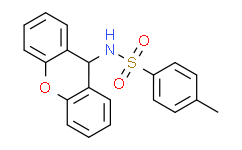| Cas No.: | 6326-06-3 |
| Chemical Name: | Benzenesulfonamide,4-methyl-N-9H-xanthen-9-yl- |
| Synonyms: | Benzenesulfonamide,4-methyl-N-9H-xanthen-9-yl-;AH 7614;4-Methyl-N-(9H-xanthen-9-yl)-benzenesulfonamide;4-methyl-N-9H-xanthen-9-yl-Benzamide;N-(9-xanthyl)-4-toluensulfonamide;N-(9-Xanthyl)-p-toluamid;N-(9-xanthyl)-p-toluensulfonamide;N-xanthen-9-yl-p-toluamide;N-xanthen-9-yl-toluene-4-sulfonamide;N-Xanthen-9-yl-toluol-4-sulfonamid;N-xanthyl-p-toluenesulfonamide |
| SMILES: | CC1C=CC(S(NC2C3=C(C=CC=C3)OC3C2=CC=CC=3)(=O)=O)=CC=1 |
| Formula: | C20H17NO3S |
| M.Wt: | 351.418884038925 |
| Purity: | >98% |
| Sotrage: | 2 years -20°C Powder, 2 weeks 4°C in DMSO, 6 months -80°C in DMSO |
| Description: | AH-7614 is a potent and selective FFA4 antagonist, with pIC50s of 7.1, 8.1, and 8.1 for human, mouse, and rat FFA4, respectively. AH-7614 has selectivity for FFA4 over FFA1 (pIC50<4.6). AH-7614 is also a negative allosteric modulator (NAM) of FFA4. AH-7614 is able to block effects of both the polyunsaturated ω-6 fatty acid linoleic acid and the synthetic FFA4 agonist[1][2]. |
| Target: | pIC50: 7.1 (human FFA4)[1] |
| In Vivo: | AH7614 (50 μg; intratumoral injection once every 4 d for 20 d) reduces the tumor growth in mice[3]. AH7614 (50 μg; intratumoral injection one day prior to epirubicin injection) enhances cancer cell sensitivity to the chemotherapy and inhibit tumor progression by blocking GPR120 signaling in combination with Epirubicin[3]. |
| In Vitro: | AH-7614 (compound 39) (0.063-1 μM) blocks intracellular Ca2+ response induced by both linoleic acid and FFAR4 agonist in FFA4 expressing U2OS cells[1]. AH-7614 (100 μM) abolishes the enhancement in glucose-stimulated insulin secretion by GSK137647A in NCI-H716 cells[1]. AH-7614 (0.001-10 μM; 15 min) blocks TUG-891-mediated internalization of FFA4 from the cell surface (pIC50=7.70)[2]. AH-7614 (10 μM; 30 min) blocks agonist-induced elevation of intracellular inositol monophosphates and phosphorylation of FFA4[2]. |
| References: | [1]. Sparks SM, et, al. Identification of diarylsulfonamides as agonists of the free fatty acid receptor 4 (FFA4/GPR120). Bioorg Med Chem Lett. 2014 Jul 15;24(14):3100-3. [2]. Watterson KR, et, al. Probe-Dependent Negative Allosteric Modulators of the Long-Chain Free Fatty Acid Receptor FFA4. Mol Pharmacol. 2017 Jun;91(6):630-641. [3]. Wang X, et, al. Fatty acid receptor GPR120 promotes breast cancer chemoresistance by upregulating ABC transporters expression and fatty acid synthesis. EBioMedicine. 2019 Feb;40:251-262. |

 To enhance service speed and avoid tariff delays, we've opened a US warehouse. All US orders ship directly from our US facility.
To enhance service speed and avoid tariff delays, we've opened a US warehouse. All US orders ship directly from our US facility.




















